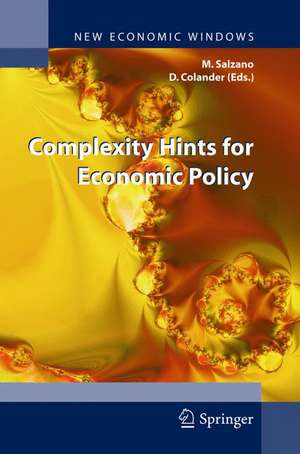Complexity Hints for Economic Policy: New Economic Windows
Editat de Massimo Salzano, David Colanderen Limba Engleză Hardback – 19 feb 2007
| Toate formatele și edițiile | Preț | Express |
|---|---|---|
| Paperback (1) | 832.11 lei 6-8 săpt. | |
| Springer – 30 oct 2014 | 832.11 lei 6-8 săpt. | |
| Hardback (1) | 647.08 lei 6-8 săpt. | |
| Springer – 19 feb 2007 | 647.08 lei 6-8 săpt. |
Din seria New Economic Windows
-
 Preț: 363.47 lei
Preț: 363.47 lei - 18%
 Preț: 953.97 lei
Preț: 953.97 lei -
 Preț: 398.74 lei
Preț: 398.74 lei -
 Preț: 386.81 lei
Preț: 386.81 lei - 15%
 Preț: 635.15 lei
Preț: 635.15 lei - 18%
 Preț: 1395.63 lei
Preț: 1395.63 lei - 18%
 Preț: 791.09 lei
Preț: 791.09 lei - 18%
 Preț: 781.77 lei
Preț: 781.77 lei - 18%
 Preț: 951.29 lei
Preț: 951.29 lei -
 Preț: 379.09 lei
Preț: 379.09 lei - 15%
 Preț: 644.63 lei
Preț: 644.63 lei -
 Preț: 399.67 lei
Preț: 399.67 lei -
 Preț: 390.46 lei
Preț: 390.46 lei -
 Preț: 386.00 lei
Preț: 386.00 lei - 18%
 Preț: 941.82 lei
Preț: 941.82 lei -
 Preț: 389.70 lei
Preț: 389.70 lei - 18%
 Preț: 729.23 lei
Preț: 729.23 lei - 18%
 Preț: 951.91 lei
Preț: 951.91 lei - 18%
 Preț: 949.10 lei
Preț: 949.10 lei - 15%
 Preț: 643.00 lei
Preț: 643.00 lei - 15%
 Preț: 645.47 lei
Preț: 645.47 lei - 15%
 Preț: 585.40 lei
Preț: 585.40 lei - 15%
 Preț: 695.53 lei
Preț: 695.53 lei - 15%
 Preț: 636.63 lei
Preț: 636.63 lei - 18%
 Preț: 786.66 lei
Preț: 786.66 lei - 15%
 Preț: 634.18 lei
Preț: 634.18 lei - 18%
 Preț: 1112.15 lei
Preț: 1112.15 lei
Preț: 647.08 lei
Preț vechi: 761.27 lei
-15% Nou
Puncte Express: 971
Preț estimativ în valută:
123.82€ • 132.41$ • 103.24£
123.82€ • 132.41$ • 103.24£
Carte tipărită la comandă
Livrare economică 18 aprilie-02 mai
Preluare comenzi: 021 569.72.76
Specificații
ISBN-13: 9788847005334
ISBN-10: 8847005337
Pagini: 336
Ilustrații: XXIII, 311 p.
Dimensiuni: 155 x 235 x 24 mm
Greutate: 0.6 kg
Ediția:2007
Editura: Springer
Colecția Springer
Seria New Economic Windows
Locul publicării:Milano, Italy
ISBN-10: 8847005337
Pagini: 336
Ilustrații: XXIII, 311 p.
Dimensiuni: 155 x 235 x 24 mm
Greutate: 0.6 kg
Ediția:2007
Editura: Springer
Colecția Springer
Seria New Economic Windows
Locul publicării:Milano, Italy
Public țintă
Professional/practitionerCuprins
General Issues.- Rationality, learning and complexity: from the Homo economicus to the Homo sapiens.- The Confused State of Complexity Economics: An Ontological Explanation.- Modeling Issues I: Modeling Economic Complexity.- The Complex Problem of Modeling Economic Complexity.- Visual Recurrence Analysis: Application to Economic Time series.- Complexity of Out-of-Equilibrium Play in Tax Evasion Game.- Modeling Issues II: Using Models from Physics to Understand EconomicPhenomena.- A New Stochastic Framework for Macroeconomics: Some Illustrative Examples.- Probability of Traffic Violations and Risk of Crime: A Model of Economic Agent Behavior.- Markov Nets and the NetLab Platform: Application to Continuous Double Auction.- Synchronization in Coupled and Free Chaotic Systems.- Agent Based Models.- Explaining Social and Economic Phenomena by Models with Low or Zero Cognition Agents.- Information and Cooperation in a Simulated Labor Market: A Computational Model for the Evolution of Workers and Firms.- Applications.- Income Inequality, Corruption, and the Non-Observed Economy: A Global Perspective.- Forecasting Inflation with Forecast Combinations: Using Neural Networks in Policy.- Policy Issues.- The Impossibility of an Effective Theory of Policy in a Complex Economy.- Implications of Scaling Laws for Policy-Makers.- Robust Control and Monetary Policy Delegation.
Textul de pe ultima copertă
This volume extends the complexity approach to economics. This complexity approach is not a completely new way of doing economics, and that it is a replacement for existing economics, but rather the integration of some new analytic and computational techniques into economists’ bag of tools. It provides some alternative pattern generators, which can supplement existing approaches by providing an alternative way of finding patterns than be obtained by the traditional scientific approach. On this new kind of policy hints can be obtained.
The reason why the complexity approach is taking hold now in economics is because the computing technology has advanced. This advance allows consideration of analytical systems that could not previously be considered by economists. Consideration of these systems suggested that the results of the "control-based" models might not extend easily to more complicated systems, and that we now have a method—piggybacking computer assisted analysis onto analytic methods—to start generating patterns that might provide a supplement to the standard approach. It is that approach that we consider the complexity approach.
The papers in this volume develop these ideas. In terms of policy the papers suggest that economists should become a bit less certain in their policy conclusions, and that they expand their bag of tools supplementing their standard model with some additional models including (1) agent based models, in which one does not use analytics to develop the pattern, but instead one uses computational power to deal with specification of models that are far beyond analytic solution; and (2) non-linear dynamic stochastic models many of which are beyond analytic solution, but whose nature can be discovered by a combination of analytics and computer simulations.
The volume is divided into four sections: general issues, modeling issues, applications, and policy issues. Each struggles with complicated ideas relatedto our general theme, and a number of them try out new techniques.
The reason why the complexity approach is taking hold now in economics is because the computing technology has advanced. This advance allows consideration of analytical systems that could not previously be considered by economists. Consideration of these systems suggested that the results of the "control-based" models might not extend easily to more complicated systems, and that we now have a method—piggybacking computer assisted analysis onto analytic methods—to start generating patterns that might provide a supplement to the standard approach. It is that approach that we consider the complexity approach.
The papers in this volume develop these ideas. In terms of policy the papers suggest that economists should become a bit less certain in their policy conclusions, and that they expand their bag of tools supplementing their standard model with some additional models including (1) agent based models, in which one does not use analytics to develop the pattern, but instead one uses computational power to deal with specification of models that are far beyond analytic solution; and (2) non-linear dynamic stochastic models many of which are beyond analytic solution, but whose nature can be discovered by a combination of analytics and computer simulations.
The volume is divided into four sections: general issues, modeling issues, applications, and policy issues. Each struggles with complicated ideas relatedto our general theme, and a number of them try out new techniques.
Caracteristici
Includes supplementary material: sn.pub/extras
















